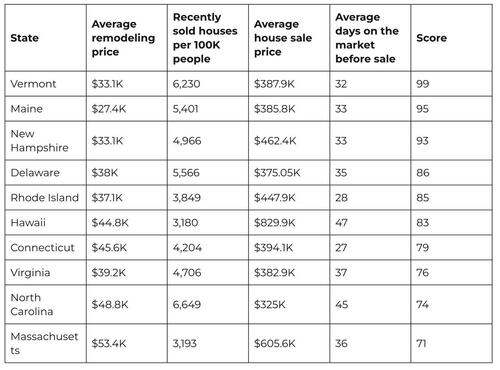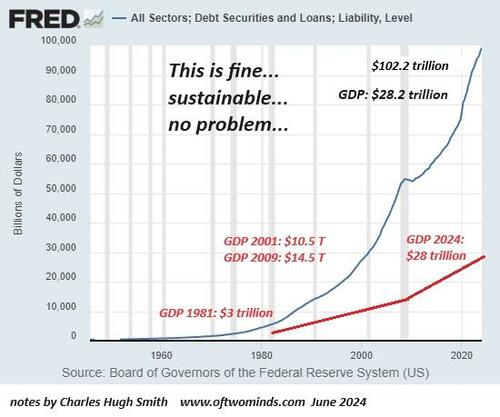Authored by Waters and Ellwanger via RealClearWorld,
President Trump’s supporters have denounced the federal judges seeking to stall or stop this administration’s government overhaul. But there is at least one person who, despite a show of outrage and condemnation, is neither surprised nor intimidated: Trump himself.

The politically appointed judges have ordered, among other actions, that federal agencies reinstate thousands of fired probationary employees; that billions of taxpayer dollars be paid to questionable USAID projects and contractors; and that foreign-born criminals deported to their native countries be returned and granted due process. Regardless of the legal merits, the American people recognize these orders as obstructions to what Trump said he would do if elected, and what voters elected him to do. Yet the judges’ resistance is expected—they’re bound up in and rewarded by the system Trump seeks to reform.
Two-thirds of Americans believe the “system” is broken, but for years progressive politicians and their mouthpieces posited that the system couldn’t be fixed. Intellectuals on the Left, including New York Times columnist David Brooks, said America’s flaws were “systemic” in nature: systemic racism, systemic sexism, and systemic injustice. They whined and preached but offered no solutions for the millions of Americans of all races and both genders struggling and failing to unlock their potential to succeed.
When Trump announced his candidacy for president in 2015, he too claimed the system was broken, but not because we are racist or sexist by nature, but because the system itself is old, soft, and corrupt, with leaders grown unresponsive to the people they are supposed to serve. That core belief guided his first term and remains unchanged at the start of his second.
For decades, politicians failed to respond to real problems because their agendas, even their identities, were phony, crafted by consultants and pollsters who aimed not for the truth, but for whichever lies or provocations were most efficacious in winning the next election. But one need not resort to craven and conspiratorial explanations of this sort, which hint that elected officials deliberately ignore the public will. The truth is simpler. They have to ignore voters, if only because they have no idea how to fix the problems we face.
In one sense, the elites’ ineptitude is understandable: we have a highly complex society that has undergone a recent, rapid, destabilization brought on by technological advance. But to admit that they simply don’t know how to address any contemporary issue would be to concede that it is only their mere status as “elites” that qualifies them to rule. Thus, to conceal their befuddlement, they explain their inaction by a vague demand that we address the “root causes” of every issue – which further justifies them in doing nothing.
The bad faith inherent to the “root causes” strategy was nowhere more obvious than at the border. For years, establishment voices told us that border security measures would fail without addressing the “root causes” of the problem: central American poverty and climate change. These appeals allowed the political class to avoid doing what they didn’t want to do (securing the border) and to manufacture a duty to do the things they did want to do (diverting American revenue to foreign aid “relief programs” and enacting more restrictive environmental policies). Aside from those interventions, they assured us, there was nothing we could do about the illegal immigration crisis.
But as it often happens, Trump called their bluff. Somehow, he managed to end the flood of illegal crossings within weeks of taking office. And contrary to the best wisdom of the “experts,” it didn’t require a grand congressional bargain like the betrayal that Sen. Lankford (R-OK) offered as a solution. Nor did it require a new climate deal. We didn’t have to make Honduras great again to stop the caravans. No – as it turned out, the answer was staring us in the face. The solution was one that could be intuited by any American voter: just secure the border. Only a class as feckless and clueless as our politicians couldn’t grasp this. But Trump understood it. And Americans see that.
Barring any real action to improve the lot of regular Americans, the lost and divided Democrats cast about for a “message” and a “messenger” to improve their chances in the next election. They believe a magic word or slogan (“nazis,” “oligarchs,” “authoritarians,” and “autocrats” all have been tried and failed), rather than concrete beliefs and plans, will “meet this moment” and win over American voters. But voters know the Democratic Party lacks anything affirmative or real.
Politicians will never make America great again, Trump said at his campaign kick-off in 2015. “They’re controlled fully by the lobbyists, by the donors, and by the special interests. “[And] it’s destroying our country.” Unlike Bush, Obama, and Biden, Trump spoke to what people felt in the Rust Belt and the Bible Belt and the Farm Belt. He looked into the vast interior of the country and understood what many Americans knew all too well: that working hard and playing by the rules no longer guaranteed their children would be better off than they had been.
Speaking about politicians in 2015, Trump said: “I hear their speeches. They don’t talk jobs. [They] have no competence. [They] don’t know what’s happening.” His message of “America First” was clear and authentic, and it implied real action and solid outcomes: protect jobs, livelihoods, and futures of Americans. The hapless politicians had nothing to counter.
“The Resistance” to the first Trump administration was advanced by the machinations of bureaucrats in the vast regulatory state. But with the president rapidly dismantling that apparatus, a new strategy was needed. For the Resistance 2.0, it seems the establishment will depend on the courts to thwart the democratically-expressed will of the people. But there is a higher court in this land, where American voters serve as judge, jury, and executor.
Earlier this month at the Department of Justice, Trump warned of the “violent, vicious lawyers” who persecute the president and bully the American public to get their way. Expect these lawyers to “play the ref,” Trump said, weaving in a story about former Indiana University basketball coach Bobby Knight, who once threw a chair across the court and screamed like a madman at the referees for a call to be overturned. The referee wasn’t going to change the first call, Trump said of Knight’s rationale for throwing the tantrum. “But he’s going to change for the next play. And sure as hell, he did.” Trump understands that activist lawyers and progressive pundits will put heat on the judiciary, and that, on occasion, they’ll get their way.
For 10 years, Trump has confronted the political class, calling out their incompetence and dishonesty, and the voters continue to reward him. Federal judges, egged on by the politically-motivated legal establishment, may try to frustrate the president in his pursuit of long-held promises to build a better country. But Trump is building his case outside the courts – and he’s betting on a sympathetic hearing with the American people, who will note the overt evidence of bias, corruption, and incompetence, whether it occurs in the media, executive branch, or the judiciary. Judges will rule on procedure and technicalities, but the people will evaluate the legitimacy of our institutions and credibility of our leaders.
In 2028, the jury will render its verdict.
John J. Waters is a lawyer. He served as a deputy assistant secretary of Homeland Security from 2020-21. Follow him at @JohnJWaters1 on X.
Adam Ellwanger is a professor at University of Houston – Downtown, where he teaches rhetoric and writing. Follow him at @1HereticalTruth on X.







